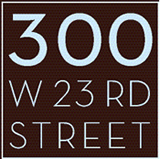Our Historical Neighborhood – An Anecdotal History of New York City with Glimpses into the Past of Particular Relevance to 300 West 23rd Street
Our neighbor Joe Polacek offers us this look at our surroundings – part memoir and part historical discourse – to enhance our appreciation for our building and neighborhood.
Chapter 4
As New York grew, the boroughs beyond Manhattan were joined to the city. With each addition, the physical center of the city also continued to change. If you happen to be visiting the area of Prospect Park, in Brooklyn, you can visit one such former center of New York City and see a plaque imbedded in the ground. This is the “Central Park” of Brooklyn!
The Flatiron building is one of the very special buildings in our neighborhood. When it was completed, it was the “tallest building in the world.” This building gets its name from the fact that its footprint bears the shape of an old-fashioned flat iron.
There is another humorous story that relates to the Flatiron building. The strong winds from the Hudson River blow eastward and the slant of the building pushes the winds north. At the same time, the winds from the East River blow west along 23rd Street and then northward also. When the building was first built, young boys would sit in the park across the street and watch as the young girls passed, hoping for a glimpse of their ankles as the winds blew the girls’ long skirts in the air. This practice continued for a long time until the cops became informed of the problem and were ordered to chase away the young boys with the words: “Skid-doo,” hence “23 Skid-doo,” for 23rd Street, an expression some of the old-timers still use.
In the same area, the original Madison Square Garden stood at 25th Street and Madison Avenue. Although it was not a garden, its close proximity to Madison Square Park gave it the name of the Garden. It was originally built as a showplace for the horse shows of the wealthy elite of New York society. Basically, that was all it was, an arena with seats surrounding a ring where the high-society set could watch the horse shows and exhibitions.
It did have a world-class restaurant on the rooftop. At this very place, the famed architect Stanford White was shot and killed by Harry K. Thaw, the son of a very wealthy New York family. Harry had married the very beautiful model and cover girl Evelyn Nesbit.
It seems that Evelyn was also an object of Stanford White’s great desire. At one point, he lured Evelyn to an apartment on 26th Street between 7th and 8th Avenues where he plied her with drink and made her swing on a swing suspended from the high ceiling. When this story was later made into a movie, the title was The Girl in the Red Velvet Swing.
When Harry learned of this, he confronted White at the lovely open-air restaurant atop Madison Square Garden and shot him. Due to his money and influence, Thaw never went to jail but spent the rest of his life in an asylum as a result of his plea of insanity. Evelyn, his wife, lived until recently and served as a consultant for the movie. The murder scene also appears at the beginning of the movie Ragtime.
Later, Madison Square Garden was moved to 50th Street and 8th Avenue, across from what was at that time the famed Polyclinic Hospital where Rudolph Valentino died. At this new location, many celebrated events took place, including the wedding reception for Elizabeth Taylor and Mike Todd. Of course, now that spot is the location of yet another tall black office building. Today, Madison Square Garden is at 32nd and 8th Avenue, right out our windows!
Seeing New York as it is today, it is hard to think of it as a place filled with trees, brooks, and streams. But in fact that was early New York. It may surprise many of you to know that even under our building there is still a stream that flows uninterruptedly, as well as one in the lobby of No. 1 Fifth Avenue. Many names of present locations reflect the ponds and bays of days gone by. Such names as Turtle Bay and Kips Bay describe the topography of the original area.
Ice houses were also very important to early New York. One such ice house remains on 24th Street off 10th Avenue. The ice was hand cut upstate in New York’s fresh water lakes, dragged to the Hudson River, and packed on barges in huge blocks. Straw separated the various blocks and prevented then from freezing together on the long journey down the river to the city. The ice was then put into specially made ice houses and used year round.
One large ice house was located near the slaughter houses, the present location of the United Nations. The ice was then broken into smaller quantities, sold to the icemen, and again sold by the icemen to the New Yorkers of those days not so long ago. My mother used to buy 5- or 10-cents worth of ice, depending on the time of year and the temperature. As kids, we loved picking up the chips of ice from the big blocks and sucking on them as our ice cream cones. During the Depression, we had no money for such luxuries as ice cream – ice had to suffice.
![]() All documents are in Adobe Acrobat (PDF) format.
All documents are in Adobe Acrobat (PDF) format.
Need Free Acrobat reader software?
Click here.
© Copyright 300 W 23rd Building 2025
